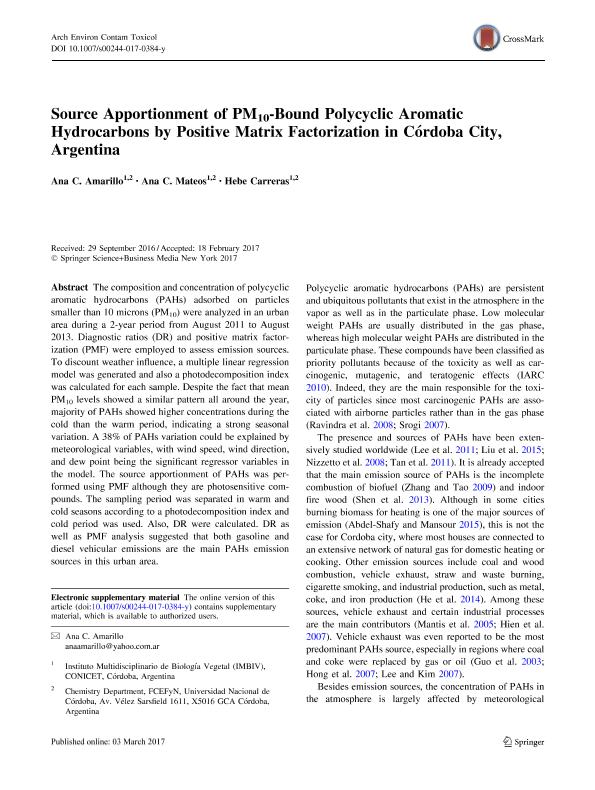Artículo
Source Apportionment of PM10-Bound Polycyclic Aromatic Hydrocarbons by Positive Matrix Factorization in Córdoba City, Argentina
Fecha de publicación:
03/2017
Editorial:
Springer
Revista:
Archives of Environmental Contamination and Toxicology
ISSN:
0090-4341
e-ISSN:
1432-0703
Idioma:
Inglés
Tipo de recurso:
Artículo publicado
Clasificación temática:
Resumen
The composition and concentration of Polycyclic Aromatic Hydrocarbons (PAHs) adsorbed on particles smaller than 10 microns (PM10) were analyzed in an urban area during a two-year period from August 2011 to August 2013. Diagnostic ratios (DR) and Positive Matrix Factorization (PMF) were employed to assess emission sources. To discount weather influence, a multiple linear regression model was generated and also a photodecomposition index was calculated for each sample. Despite the fact that mean PM10 levels showed a similar pattern all around the year, majority of PAHs showed higher concentrations during the cold than the warm period, indicating a strong seasonal variation. A 38 % of PAHs variation could be explained by meteorological variables, with wind speed, wind direction and dew point being the significant regressor variables in the model. The source apportionment of PAHs was carried out using PMF although they are photosensitive compounds. To do this the sampling period was separated in warm and cold seasons according to a photodecomposition index and cold period was used. Also, DR were calculated. DR as well as PMF analysis suggested that both gasoline and diesel vehicular emissions, are the main PAHs emission sources in this urban area.
Archivos asociados
Licencia
Identificadores
Colecciones
Articulos(IMBIV)
Articulos de INST.MULTIDISCIPL.DE BIOLOGIA VEGETAL (P)
Articulos de INST.MULTIDISCIPL.DE BIOLOGIA VEGETAL (P)
Citación
Amarillo, Ana Carolina; Mateos, Ana Carolina; Carreras, Hebe Alejandra; Source Apportionment of PM10-Bound Polycyclic Aromatic Hydrocarbons by Positive Matrix Factorization in Córdoba City, Argentina; Springer; Archives of Environmental Contamination and Toxicology; 72; 3; 3-2017; 380-390
Compartir
Altmétricas




